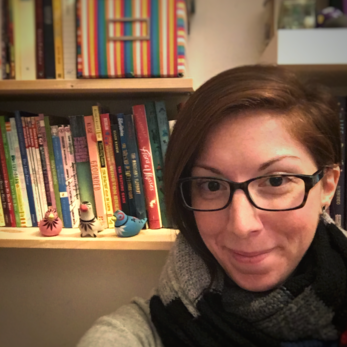Teresa Bonaddio, Running Press
At the time of this interview, Teresa Bonaddio was senior designer at Running Press in Philadelphia.

How did you get to where you are in the world of publishing and design?
I started my publishing career as an intern in the kid’s editorial department of Running Press. Coincidentally, when that was ending, a job opened up on the lowest rung of their editorial department, and from there I moved up about three rungs to associate editor. Eventually, I went back to focus on the visual art aspect of life. My undergrad was a B.F.A. in printmaking and book arts from University of the Arts. I went to the Maryland Institute College of Art for a graduate degree in graphic design and then wound up coming back to Philadelphia to be a designer at Running Press. I reconnected with one of my coworkers, and they just so happened to have a job opening. So now I’m back, on the design side of things.
What is the process of making a children’s book?
A lot of children’s books are agented, especially middle grade and teen Young Adult, but there are also a lot of projects and ideas that actually come about through in-house development. We create the text or do a work-for-hire agreement, in which we find a writer who we feel is great for a project, and commission them to complete it. Then the company owns the project. In the children’s book world, you don’t have to have an agent, especially with picture books and illustrators. I think oftentimes those types of projects can come into your inbox unsolicited in a way that’s serendipitous. It ended up with the right person for the right reasons.
How do designers work with authors and editors?
We go through various stages. When the designers get the manuscript, we’re faced with the task of creating a look and feel for it. We have conversations with the editor about whether the book will be done with illustration or photography. We bring options and samples to the table and have a group discussion about it. There is a step where we share options with the author. At these check-in points, we do design samples with sketches and illustrations, and then the designers lay it out and oftentimes come up with two or three variations for each page. We’ll review that and say what works and what doesn’t work. Sometimes it’s a mix-and-match game, and there is a lot of back and forth. But ultimately, the author is always consulted in some way because we want them to like their book and also do well in the marketplace.
How many book projects are you usually working on at any given time?
We’re usually working on 15 to 30 projects at various overlapping stages. For example, right now we’re working on getting spring ’16 out the door, developing fall ’16 and acquiring projects for spring ’17.
With all of these projects, how are you able to find time for your own creative work?
It’s an everyday challenge, but you have to create habits for yourself. I grasp any time I can, whether it’s my commute or my lunch break, for thinking or jotting down an idea. Sometimes I come home from work, take a breather and then say “okay, I’m going to work on my own project from eight to eleven.” It’s about establishing time for yourself, whether you’re doing it for more money or even for more work that’s gratifying in another way.
What advice would you offer to young people trying to get into the world of publishing?
The publishing world is a mentor-based industry, and most people start out as interns. At a publishing house, they take you under their wing. Publishing is a ladder-climbing industry in that you’re always looking to go up the next notch and take on more responsibility. I worked a lot of projects that I didn’t want to as an assistant, but I found that the more different people I worked with, the more I learned. Even if you have to start at the bottom, you can always learn from the people around you.
— Alyssa Evans '16